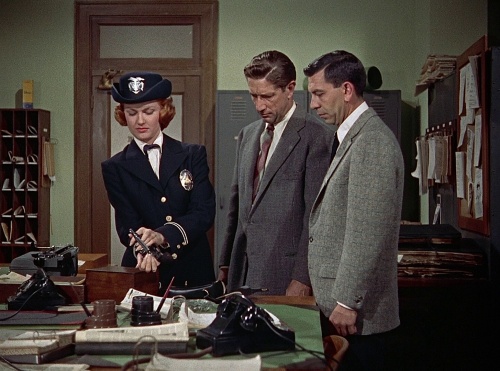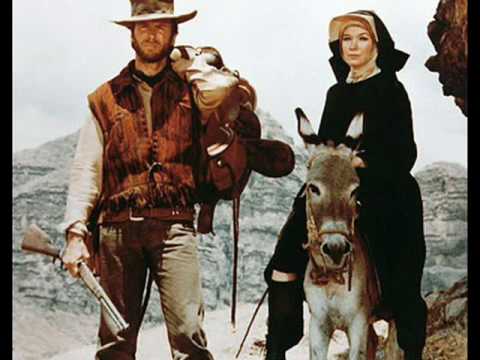« October 2020 | Main | December 2020 »
November 10, 2020
Dragnet

Jack Webb - 1954
KL Studio Classics BD Region A
Jack Webb's TV series has been a part of my life since its first version in the 1950s. I was a bit too young to follow what all of the details when I watched the occasional episode during the final year or so, around 1959. The introductory four notes at the beginning of the show and Webb's deadpan request of "Just the facts" were well ingrained as part of the general popular culture of the time. Even as a would be high school aged hippie in the late 1960s, I watched Jack Webb's police Sergeant, Joe Friday, back in prime time television, but something of a man out of his time with the current zeitgeist. My affection for Dragnet also included catching the 1987 film with Dan Ackroyd as the nephew, also named Joe Friday.
The series began on the radio, and the original TV series is almost filmed radio. Primarily dialogue based with Friday and his partner, Frank Smith, driving around Los Angeles, interviewing witnesses and possible suspects. Purportedly based on true life crimes, each episode ends with the perpetrator caught, and the sentence announced at the end. There is not much of interest visually, mostly close-ups and medium shots of people talking. The emphasis is on the procedures and ordinary legwork of solving a crime. The film takes an entirely different tack, with Friday and Smith having to find the material evidence needed for proof of the crime.
Much of the movie version is like a big screen version of what was seen at home. But Webb, as director, also takes Dragnet where he would not have been able to for home consumption. The film opens with the shooting in a field of one small time hood by another. The killer has a saw-off shotgun. The victim, an uncredited Dub Taylor, is in the foreground, while the killer can be seen several yards back. Taylor's back is to the camera. When he is first shot, he twists towards the camera in close-up revealing a bloody face. Given when the film was made, this is an extremely violent moment. Later, Friday and Smith get into a fist fight with some gamblers with everyone getting bloody and bruised. That fist fight also has plenty of Point-of-View shots with the viewer being the recipient of several of Friday's punches to the face. The dialogue also goes beyond what would be allowed on television with Friday responding to a hoodlum's crack about his mother, with Friday responding that unlike the hood, his mother "doesn't bark". Unlike the television show, Webb here has a few opportunities to create shots with one character in the foreground with another further back, as well as using a few overhead traveling crane shots. What bits of cinematic style exist here would be explored more thoroughly the following year with Webb's best film, Pete Kelly's Blues.
Webb was unusually generous for a producer-director-star. Both Dragnet and Pete Kelly's Blues have credits with a card following Webb's name as "in the Screen Play by Richard L. Breen". These were the only two films that Breen wrote for Webb, and the only two films that Webb provided the unusual credit for writing. While the visual aspects of Webb's films are inconsistent, there are thematic consistencies. Webb's films are about generally homosocial groups, be it the police force in Dragnet, the 1920s Kansas City jazz band of Pete Kelly's Blues, the marines in The D.I. or the newsmen in -30-. Even the women, Ann Robinson as a police woman here, are essentially one of the guys. The lives of these characters are within their chosen professional activities.
Film historian Toby Roan provides the commentary track for the Blu-ray. Identification and some details are provided on the supporting cast that includes Richard Boone, and uncredited Dennis Weaver, and an assortment of character actors with careers often weaving between radio, television and movies. Roan's commentary track can be heard on the wide screen version of the film (1.75:1). Dragnet is also available in the Academy format of 1.37:1. What I am assuming is that the film was intended to be exhibited in the standard 35mm format, but Warner Brothers wanted to hop onto some kind of wide screen format following the introduction of CinemaScope the previous year. Dragnet was one of several films that were re-formatted for wide screen during this transitional period. While there is no significant loss of visual information, my own preference is for the Academy ratio. Dragnet can also be enjoyed for some of the on location filming around the streets of Los Angeles. Even while very much a product of its time, Jack Webb's creation not only thrived through the changes in mass media and popular culture, but has remained defiantly iconic.
Posted by Peter Nellhaus at 06:59 AM
November 03, 2020
Two Mules for Sister Sara

Don Siegel - 1970
KL Studio Classics BD Region A Two-disc set
It is probably common knowledge by cinephiles that Two Mules for Sister Sara originated as a screenplay by filmmaker Budd Boetticher. Written in the mid-1960s, Boetticher sold the screenplay in order to continue working on his passion project, the documentary on bullfighter Carlos Arruza. The screenplay was bought by producer Martin Rackin. According to Boetticher, he had made a disparaging remark about some jokes Rackin had written when both were working at Universal in the early 1950s. Although Boetticher wrote the screenplay with the intention of directing the film, he knew that Rackin would not hire him.
Boetticher had intended to make the film with Robert Mitchum and either Jeanne Moreau, Sylvia Pinal or Deborah Kerr in the title role. The film that was made, with a total re-writing of the screenplay by the formerly blacklisted Albert Maltz can be seen in retrospect as a kind of transitional film bridging the gap between the more traditional kind of film made by Boetticher with the changes to the western brought about by the advent of the Italian films and revisionist westerns, and the onscreen persona of Clint Eastwood. Even Burt Kennedy, who wrote most of the screenplays for the Randolph Scott westerns that Boetticher is most famous for, responded to the challenge first with his adaptation of E.L. Doctorow's Welcome to Hard Times (1967). It is most likely that had Boetticher made the film he imagined, it would have been likely regarded as remote from the tastes of the audience at that time.
The influence of Sergio Leone is most obvious in Clint Eastwood's appearance - the unshaven face, the cheroot between his clenched teeth, and a rust colored vest that vaguely resembles the poncho. Add to that the score by Ennio Morricone that features a piccolo and jew's harp. Eastwood's character has a name, or at least a surname, of Hogan. A scene with the blowing up of a bridge with a moving train and an elaborate batter sequence further the connection, primarily with The Good, the Bad, and the Ugly.
The shots during the title sequence show Hogan in the distance riding with an accompanying pack horse at sunrise. This series of shots begin with an animal with the camera moving across the area within the shot to reveal something more about the environment before stopping to show Hogan's progress as he travels. The animals include a mountain lion, a snake and a rabbit. Although not as emphasized as the film progresses, as indicated by the title, part of the film is about the relationship of Hogan with the nun Sister Sara, and animals. The film takes place in Mexico during the time of the attempted French conquest, concurrent to the American Civil War. After Hogan saves Sara from a gang of would be rapists in the desert, he argues against burying the men, saying the would act as food for the vultures. The rattle of a snake is used as a decoy to mislead a group of French soldiers who are seeing Sara for her support of the Juaristas. Sara travels first on a mule, and later on a burro. The second mule in the title could well be Hogan, whom Sara addresses at one point as "Mr. Mule".
While Clint Eastwood plays a variation of the kind of character he established primarily with the Sergio Leone films, Shirley MacLaine, in the title role is the one who evolves during the course of the film. First seen almost naked when threatened by the trio of would-be rapists, her character reveals more of her self over time. First is the discovery that she and Hogan have a mutual agenda regarding aiding the Juaristas, followed by the increasing revelations that this is one very unorthodox nun. There is a narrative symmetry with having Sara again without any clothes near the end of the film when her true self is revealed.
The blu-ray comes with both the complete 113 minute "international" version and the 104 minute cut that played theatrically in the U.S. Alex Cox's commentary track is most interesting in discussing the Mexican locations for Sister Sara as well as briefly reviewing several other westerns filmed in Mexico in the late 1960s and early 1970s. Cox also covers the career of Mexican cinematographer Gabriel Figueroa. Eastwood liked Figueroa's work enough to have him hired as cinematographer for another Eastwood film released just weeks later in June 1970, Kelly's Heroes. There is also an eight minute short, an interview, "At Home with Clint Eastwood".
Two Mules for Sister Sara was meant to be seen theatrically, but home viewers should see this film on as big a screen as possible. Siegel employs several long shot where characters are barely perceptible in the distance. There is the recurring visual motif emphasizing spatial dynamics, of people almost overwhelmed by their environment.
Posted by Peter Nellhaus at 06:46 AM
